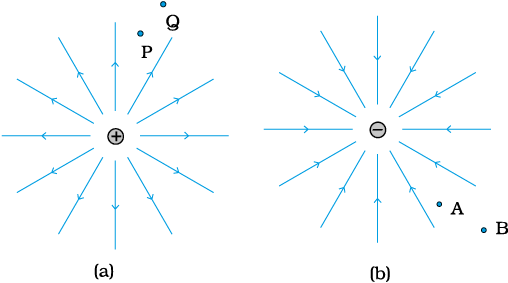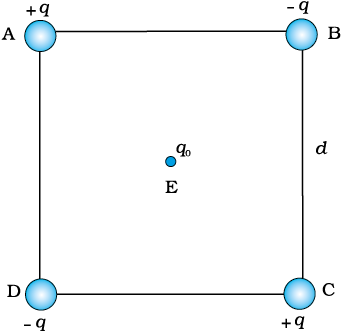The potential at a point P due to a charge of 4 × 10–7 C located 9 cm away is:
The potential at point P is . The work done in bringing a charge of 2 × 10–9 C from infinity to the point P is:
Two charges 3 × 10–8 C and –2 × 10–8 C are located 15 cm apart. At what point on the line joining the two charges is the electric potential zero? Take the potential at infinity to be zero.
1. 9 cm away from 3 × 10–8 C
2. 25 cm away from 3 × 10–8 C
3. 45 cm away from 3 × 10–8 C
4. Both (1) and (3)
Figures (a) and (b) show the field lines of a positive and negative point charge respectively.
The signs of the potential difference

Figures (a) and (b) show the field lines of a positive and negative point charge respectively. The signs of the potential energy difference of a small negative charge between the points Q and P & A and B are respectively:

Figures (a) and (b) show the field lines of a positive and negative point charge respectively. The sign of the work done by the field in moving a small positive charge from Q to P and the sign of the work done by the external agency in moving a small negative charge from B to A, respectively, will be:

Figures (a) and (b) show the field lines of a positive and negative point charge respectively. The kinetic energy of a small negative charge in going from B to A:

1. decreases.
2. increases.
3. remains the same.
4. first increases and then decreases.
Four charges are arranged at the corners of a square ABCD of side d, as shown in the figure. The work required to put together this arrangement will be:

Four charges are arranged at the corners of a square \(ABCD\) of side \(d\), as shown in the figure. A charge \(q_0\) is brought from \(\infty\) to the centre \(E\) of the square, the four charges being held fixed at its corners. How much work is needed to do this?

1. \(\frac{-q^2}{4\pi\varepsilon_0 d}(4-\sqrt{2})\)
2. zero
3. \(\frac{-q^2}{4\pi\varepsilon_0 d}(4+\sqrt{2})\)
4. \(\frac{-q^2}{4\pi\varepsilon_0 d}(2+\sqrt{2})\)
The electrostatic potential energy of a system consisting of two charges 7 µC and –2 µC (and with no external field) placed at (–9 cm, 0, 0) and (9 cm, 0, 0) respectively is:
1. 0.2 J
2. -0.7 J
3. -0.2 J
4. 0.7 J






